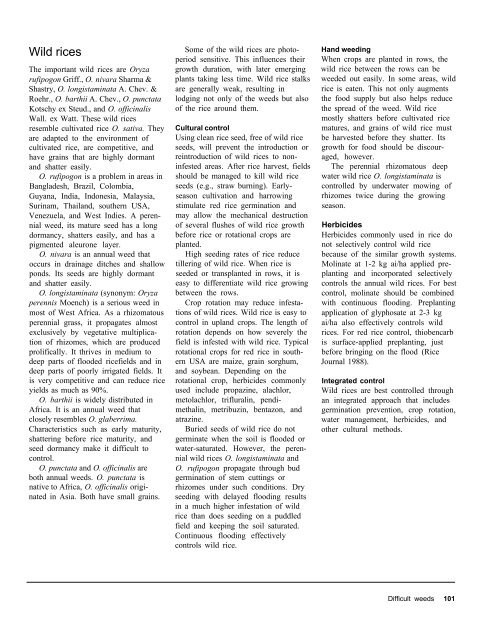A handbbok on Weed Control in Rice.pdf
A handbbok on Weed Control in Rice.pdf
A handbbok on Weed Control in Rice.pdf
Create successful ePaper yourself
Turn your PDF publications into a flip-book with our unique Google optimized e-Paper software.
Wild rices<br />
The important wild rices are Oryza<br />
rufipog<strong>on</strong> Griff., O. nivara Sharma &<br />
Shastry, O. l<strong>on</strong>gistam<strong>in</strong>ata A. Chev. &<br />
Roehr., O. barthii A. Chev., O. punctata<br />
Kotschy ex Steud., and O. offic<strong>in</strong>alis<br />
Wall. ex Watt. These wild rices<br />
resemble cultivated rice O. sativa. They<br />
are adapted to the envir<strong>on</strong>ment of<br />
cultivated rice, are competitive, and<br />
have gra<strong>in</strong>s that are highly dormant<br />
and shatter easily.<br />
O. rufipog<strong>on</strong> is a problem <strong>in</strong> areas <strong>in</strong><br />
Bangladesh, Brazil, Colombia,<br />
Guyana, India, Ind<strong>on</strong>esia, Malaysia,<br />
Sur<strong>in</strong>am, Thailand, southern USA,<br />
Venezuela, and West Indies. A peren-<br />
nial weed, its mature seed has a l<strong>on</strong>g<br />
dormancy, shatters easily, and has a<br />
pigmented aleur<strong>on</strong>e layer.<br />
O. nivara is an annual weed that<br />
occurs <strong>in</strong> dra<strong>in</strong>age ditches and shallow<br />
p<strong>on</strong>ds. Its seeds are highly dormant<br />
and shatter easily.<br />
O. l<strong>on</strong>gistam<strong>in</strong>ata (syn<strong>on</strong>ym: Oryza<br />
perennis Moench) is a serious weed <strong>in</strong><br />
most of West Africa. As a rhizomatous<br />
perennial grass, it propagates almost<br />
exclusively by vegetative multiplica-<br />
ti<strong>on</strong> of rhizomes, which are produced<br />
prolifically. It thrives <strong>in</strong> medium to<br />
deep parts of flooded ricefields and <strong>in</strong><br />
deep parts of poorly irrigated fields. It<br />
is very competitive and can reduce rice<br />
yields as much as 90%.<br />
O. barthii is widely distributed <strong>in</strong><br />
Africa. It is an annual weed that<br />
closely resembles O. glaberrima.<br />
Characteristics such as early maturity,<br />
shatter<strong>in</strong>g before rice maturity, and<br />
seed dormancy make it difficult to<br />
c<strong>on</strong>trol.<br />
O. punctata and O. offic<strong>in</strong>alis are<br />
both annual weeds. O. punctata is<br />
native to Africa, O. offic<strong>in</strong>alis origi-<br />
nated <strong>in</strong> Asia. Both have small gra<strong>in</strong>s.<br />
Some of the wild rices are photo-<br />
period sensitive. This <strong>in</strong>fluences their<br />
growth durati<strong>on</strong>, with later emerg<strong>in</strong>g<br />
plants tak<strong>in</strong>g less time. Wild rice stalks<br />
are generally weak, result<strong>in</strong>g <strong>in</strong><br />
lodg<strong>in</strong>g not <strong>on</strong>ly of the weeds but also<br />
of the rice around them.<br />
Cultural c<strong>on</strong>trol<br />
Us<strong>in</strong>g clean rice seed, free of wild rice<br />
seeds, will prevent the <strong>in</strong>troducti<strong>on</strong> or<br />
re<strong>in</strong>troducti<strong>on</strong> of wild rices to n<strong>on</strong>-<br />
<strong>in</strong>fested areas. After rice harvest, fields<br />
should be managed to kill wild rice<br />
seeds (e.g., straw burn<strong>in</strong>g). Early-<br />
seas<strong>on</strong> cultivati<strong>on</strong> and harrow<strong>in</strong>g<br />
stimulate red rice germ<strong>in</strong>ati<strong>on</strong> and<br />
may allow the mechanical destructi<strong>on</strong><br />
of several flushes of wild rice growth<br />
before rice or rotati<strong>on</strong>al crops are<br />
planted.<br />
High seed<strong>in</strong>g rates of rice reduce<br />
tiller<strong>in</strong>g of wild rice. When rice is<br />
seeded or transplanted <strong>in</strong> rows, it is<br />
easy to differentiate wild rice grow<strong>in</strong>g<br />
between the rows.<br />
Crop rotati<strong>on</strong> may reduce <strong>in</strong>festa-<br />
ti<strong>on</strong>s of wild rices. Wild rice is easy to<br />
c<strong>on</strong>trol <strong>in</strong> upland crops. The length of<br />
rotati<strong>on</strong> depends <strong>on</strong> how severely the<br />
field is <strong>in</strong>fested with wild rice. Typical<br />
rotati<strong>on</strong>al crops for red rice <strong>in</strong> south-<br />
ern USA are maize, gra<strong>in</strong> sorghum,<br />
and soybean. Depend<strong>in</strong>g <strong>on</strong> the<br />
rotati<strong>on</strong>al crop, herbicides comm<strong>on</strong>ly<br />
used <strong>in</strong>clude propaz<strong>in</strong>e, alachlor,<br />
metolachlor, triflural<strong>in</strong>, pendi-<br />
methal<strong>in</strong>, metribuz<strong>in</strong>, bentaz<strong>on</strong>, and<br />
atraz<strong>in</strong>e.<br />
Buried seeds of wild rice do not<br />
germ<strong>in</strong>ate when the soil is flooded or<br />
water-saturated. However, the peren-<br />
nial wild rices O. l<strong>on</strong>gistam<strong>in</strong>ata and<br />
O. rufipog<strong>on</strong> propagate through bud<br />
germ<strong>in</strong>ati<strong>on</strong> of stem cutt<strong>in</strong>gs or<br />
rhizomes under such c<strong>on</strong>diti<strong>on</strong>s. Dry<br />
seed<strong>in</strong>g with delayed flood<strong>in</strong>g results<br />
<strong>in</strong> a much higher <strong>in</strong>festati<strong>on</strong> of wild<br />
rice than does seed<strong>in</strong>g <strong>on</strong> a puddled<br />
field and keep<strong>in</strong>g the soil saturated.<br />
C<strong>on</strong>t<strong>in</strong>uous flood<strong>in</strong>g effectively<br />
c<strong>on</strong>trols wild rice.<br />
Hand weed<strong>in</strong>g<br />
When crops are planted <strong>in</strong> rows, the<br />
wild rice between the rows can be<br />
weeded out easily. In some areas, wild<br />
rice is eaten. This not <strong>on</strong>ly augments<br />
the food supply but also helps reduce<br />
the spread of the weed. Wild rice<br />
mostly shatters before cultivated rice<br />
matures, and gra<strong>in</strong>s of wild rice must<br />
be harvested before they shatter. Its<br />
growth for food should be discour-<br />
aged, however.<br />
The perennial rhizomatous deep<br />
water wild rice O. l<strong>on</strong>gistam<strong>in</strong>ata is<br />
c<strong>on</strong>trolled by underwater mow<strong>in</strong>g of<br />
rhizomes twice dur<strong>in</strong>g the grow<strong>in</strong>g<br />
seas<strong>on</strong>.<br />
Herbicides<br />
Herbicides comm<strong>on</strong>ly used <strong>in</strong> rice do<br />
not selectively c<strong>on</strong>trol wild rice<br />
because of the similar growth systems.<br />
Mol<strong>in</strong>ate at 1-2 kg ai/ha applied pre-<br />
plant<strong>in</strong>g and <strong>in</strong>corporated selectively<br />
c<strong>on</strong>trols the annual wild rices. For best<br />
c<strong>on</strong>trol, mol<strong>in</strong>ate should be comb<strong>in</strong>ed<br />
with c<strong>on</strong>t<strong>in</strong>uous flood<strong>in</strong>g. Preplant<strong>in</strong>g<br />
applicati<strong>on</strong> of glyphosate at 2-3 kg<br />
ai/ha also effectively c<strong>on</strong>trols wild<br />
rices. For red rice c<strong>on</strong>trol, thiobencarb<br />
is surface-applied preplant<strong>in</strong>g, just<br />
before br<strong>in</strong>g<strong>in</strong>g <strong>on</strong> the flood (<strong>Rice</strong><br />
Journal 1988).<br />
Integrated c<strong>on</strong>trol<br />
Wild rices are best c<strong>on</strong>trolled through<br />
an <strong>in</strong>tegrated approach that <strong>in</strong>cludes<br />
germ<strong>in</strong>ati<strong>on</strong> preventi<strong>on</strong>, crop rotati<strong>on</strong>,<br />
water management, herbicides, and<br />
other cultural methods.<br />
Difficult weeds 101











